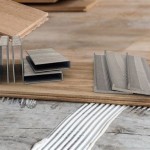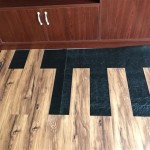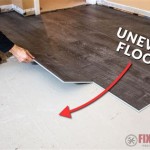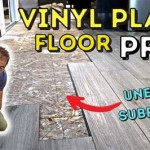Dark Hardwood Floors Decorating Ideas
Dark hardwood floors offer a sophisticated and elegant foundation for a myriad of interior design styles. Their rich hues, ranging from deep browns and blacks to charcoals and near-ebony shades, create a sense of luxury and depth in any room. However, decorating with dark hardwood requires careful consideration to avoid making the space feel small or oppressive. Strategic choices in wall colors, furniture, lighting, and accessories are crucial to achieving a balanced and visually appealing aesthetic.
One of the primary advantages of dark hardwood is its versatility. It can complement both modern and traditional designs, serving as a neutral backdrop or a dramatic focal point. The key lies in understanding how to effectively contrast and complement the darkness of the floors to create a harmonious and inviting atmosphere. This article will explore various decorating ideas that harness the beauty of dark hardwood, offering practical guidance on color palettes, furniture selection, lighting schemes, and accessory choices to maximize the potential of these striking floors.
Choosing the Right Wall Colors
Wall color is arguably the most influential factor in decorating with dark hardwood floors. The interaction between the floor and wall colors significantly impacts the perceived size, brightness, and overall mood of the room. Selecting the appropriate wall color can either accentuate the beauty of the floors or inadvertently diminish their impact.
Light and airy colors are generally recommended for rooms with dark hardwood floors. Opting for shades of white, off-white, cream, and light gray can create a striking contrast, effectively balancing the darkness and preventing the room from feeling closed in. These light colors reflect natural and artificial light, brightening the space and highlighting the richness of the floors.
Consider the specific undertones of the dark hardwood when choosing a wall color. Floors with warm undertones, such as those with hints of red or brown, pair well with warm whites, creams, or soft beiges. These combinations create a cohesive and inviting ambiance. Conversely, floors with cool undertones, like those with gray or blue nuances, complement cooler whites or light grays. These pairings result in a more modern and sophisticated look.
For those seeking a bolder approach, consider incorporating accent walls in deeper, more saturated colors. A deep teal, navy blue, or even a rich jewel tone can create a dramatic focal point without overwhelming the space. However, caution should be exercised to ensure that the overall color scheme remains balanced and well-coordinated. Using these darker accent colors sparingly and strategically, perhaps on a single wall or in alcoves, can add depth and visual interest without sacrificing the sense of openness.
Another option is to explore different shades of white. White comes in a vast array of undertones, each capable of creating a different effect. A bright, crisp white can create a modern, minimalist look, while a warmer, creamier white can evoke a more traditional feel. Experimenting with different white shades allows for subtle variations in the overall aesthetic while maintaining the fundamental principle of contrasting the dark floors with light walls.
Matte finishes are often preferred over glossy finishes for walls in rooms with dark hardwood. Matte paint absorbs light, creating a softer and more sophisticated look, while glossy paint reflects light, which can be overwhelming when paired with the already reflective surface of hardwood floors. A matte finish also helps to minimize imperfections on the walls, resulting in a smoother and more visually appealing surface.
Selecting Furniture and Textiles
The choice of furniture and textiles plays a crucial role in complementing dark hardwood floors. The scale, style, and color of these elements can either enhance the elegance of the floors or create a disjointed and unflattering effect. Careful consideration should be given to the materials, textures, and patterns used in furniture upholstery, rugs, curtains, and other decorative elements.
Light-colored furniture creates a striking contrast against dark hardwood floors, preventing the room from feeling heavy or monotonous. Sofas, chairs, and tables in shades of white, cream, beige, or light gray can provide a visual break from the darkness of the floors, adding brightness and airiness to the space. Opting for natural materials, such as linen, cotton, and wood, can further enhance the sense of warmth and comfort.
Consider the scale of the furniture in relation to the size of the room. Large, bulky furniture can overwhelm a small space, while small, delicate furniture can get lost in a larger room. Choosing furniture that is proportionally appropriate for the room will help to create a balanced and harmonious aesthetic. In smaller rooms, consider using furniture with exposed legs to create the illusion of more space.
Rugs are an essential element in decorating with dark hardwood floors. They provide warmth, comfort, and visual interest, while also helping to define different areas of the room. Light-colored rugs, such as those in shades of white, cream, or pastel, can create a striking contrast against the dark floors, brightening the space and adding a touch of elegance. Rugs with intricate patterns or textures can add visual interest and depth to the room. Consider the size and shape of the rug in relation to the furniture arrangement. A rug that is too small can make the room feel disjointed, while a rug that is too large can overwhelm the space.
Incorporate texture through throws and cushions to add an extra layer of comfort and visual appeal. Knitted throws, velvet cushions, and fur throws can add warmth and dimension to the space. Experiment with different textures and patterns to create a layered and inviting look. Consider using cushions in a variety of sizes and shapes to create a more dynamic arrangement.
Metallic accents can be used to add a touch of glamour and sophistication to the room. Gold, silver, and bronze accents can complement the richness of the dark hardwood floors, creating a sense of luxury and elegance. Consider incorporating metallic accents through lamps, mirrors, picture frames, and other decorative elements. Use these accents sparingly to avoid overwhelming the space.
Optimizing Lighting for Dark Hardwood Floors
Lighting is paramount when decorating with dark hardwood floors. Inadequate lighting can exacerbate the darkness of the floors, making the room feel gloomy and uninviting. A well-planned lighting scheme is essential for creating a bright, airy, and welcoming atmosphere.
Natural light is the most desirable source of illumination for any room. Maximize the amount of natural light entering the space by opening curtains and blinds during the day. Consider using sheer curtains to allow natural light to filter through while still providing privacy. Strategically placed mirrors can also help to reflect natural light, brightening the room and creating the illusion of more space.
Artificial lighting should be layered to provide both ambient and task lighting. Ambient lighting provides overall illumination, while task lighting provides focused light for specific activities, such as reading or cooking. A combination of overhead lighting, such as recessed lights or chandeliers, and floor and table lamps can create a well-balanced lighting scheme.
Choose light bulbs with a warm color temperature to create a cozy and inviting atmosphere. Warm light bulbs emit a yellowish glow that complements the richness of dark hardwood floors, creating a sense of warmth and comfort. Cool light bulbs, on the other hand, emit a bluish glow that can make the room feel cold and sterile.
Consider using dimmer switches to control the intensity of the lighting. Dimmer switches allow you to adjust the brightness of the lights to suit different activities and moods. Dimming the lights can create a more intimate and relaxing atmosphere, while brightening the lights can provide better visibility for tasks such as reading or working.
Under-cabinet lighting can be used to highlight the beauty of dark hardwood floors. Installing lights under cabinets in kitchens or bathrooms can create a soft and subtle glow that accentuates the grain and texture of the floors. This type of lighting can also provide additional task lighting for countertops and other work surfaces.
Track lighting offers a versatile solution for illuminating dark hardwood floors. Track lighting allows you to direct light to specific areas of the room, highlighting artwork, furniture, or architectural features. Track lighting can be adjusted to create different lighting effects, such as spotlighting or washing walls with light.
Avoid using excessively dark lampshades, which can absorb light and make the room feel even darker. Opt for light-colored lampshades that allow light to filter through, brightening the surrounding area. Lampshades made of fabric or paper can create a soft and diffused glow, while lampshades made of glass or metal can provide a brighter and more direct light.

35 Gorgeous Ideas Of Dark Wood Floors That Look Amazing

What Furniture Goes With Dark Wood Floors Calgary

Perfect Pairings What Colors Go With Dark Floors Mojo Boutique

15 Awesome Floor And Deco Ideas Installation Sigmadoors

5 Tips To Pair Dark Floors With Light Walls Real Wood

The Timeless Elegance Of Hardwood Floors In Living Rooms

Decorating Rooms With Dark Floors And Gray Walls The Flooring Girl

What Goes With Dark Wood Floors William Pitt Sotheby S Realty

Beginners Guide To Hardwood Floors And Interior Design Square One

35 Gorgeous Ideas Of Dark Wood Floors That Look Amazing
Related Posts








